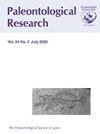俄罗斯远东滨海地区南部早三叠世bellerophonoid(腹足类)灭绝的时间
IF 0.6
4区 地球科学
Q3 PALEONTOLOGY
引用次数: 1
摘要
摘要研究了俄罗斯远东南普里莫耶七个剖面早三叠世Belleropontoidea(腹足目)的地层分布和产状,记录了从非海相、滨面到远盆平原的沉积环境。Warthia zakharovi和Dicellonema abrekensis在Induan(Griesbachian和Dienerian)细粒至中粒、丘状交错分层(HCS)砂岩层中丰富,偶尔夹有波状泥岩层,而在粗粒交错分层序列中则不存在。这一观察结果表明,在这一特定阶段,贝氏体生活在风暴波基上方的较低滨面环境中,也可能生活在内陆架环境中。Olenekian(Smithian和Spathian)Bellerophantoid未在风暴引起的砂岩层中发现,但W.zakharovi出现在夹层泥岩中的远端浊积岩的下Smithian砂岩层中。这种发生模式强烈表明,扎哈罗维生活在比下海岸面更深的环境中,很可能是内陆架环境,死后,它的外壳通过沉积物重力流从栖息地运到盆地底部。在史密森中期和南普里莫耶的年轻地层中还没有发现贝氏体,这种消失的时间与世界其他地区同步。在印度安时代,Bellerophantoids分布在从赤道到高纬度的广阔地区,但在史密西亚早期,它们从中纬度南Primorye的低纬度地区和较浅的海洋环境中消失,最终在史密希亚中期灭绝。这种循序渐进的死亡强烈暗示着,史密森时代发生的严重的全球变暖和相关的有害事件可能对贝氏体产生了严重影响。在史密森晚期开始之前,Bellerophontoidea的灭绝表明,该群体可能比其他生物对全球变暖和相关有害事件更敏感。本文章由计算机程序翻译,如有差异,请以英文原文为准。
Timing of Bellerophontoid (Gastropoda) Demise in the Early Triassic of South Primorye, Russian Far East
Abstract. The stratigraphic distribution and modes of occurrence of Early Triassic Bellerophontoidea (Gastropoda) are studied at seven sections in South Primorye, Russian Far East, where depositional environments ranging from nonmarine, shoreface, to distal basin plain settings are recorded. Warthia zakharovi and Dicellonema abrekensis are abundant in Induan (Griesbachian and Dienerian) fine- to medium-grained, hummocky cross-stratified (HCS) sandstone beds occasionally intercalated with wavy-mudstone layers, whereas they are absent in coarser-grained cross-stratified successions. This observation suggests that bellerophontoids inhabited a lower shoreface environment above the storm wave base and possibly an inner shelf environment as well during this particular stage. Olenekian (Smithian and Spathian) bellerophontoids have not been found in the storm-induced sandstone beds, but W. zakharovi occurs in the lower Smithian sandstone beds of distal turbidites intercalated in the laminated mudstone. This mode of occurrence strongly suggests that W. zakharovi inhabited a deeper environment than lower shoreface, most probably an inner shelf environment, and after death, its shells were transported from their habitat to the basin-floor by sediment gravity flow. Bellerophontoids have not been found in middle Smithian and younger strata in South Primorye, and the timing of this disappearance is synchronous with other areas of the world. Bellerophontoids were distributed over wide-ranging areas from the equator to the high latitudes during Induan time, but they disappeared from the lower latitude areas and the shallower marine environments of middle latitude South Primorye during the early Smithian, before eventually becoming extinct during middle Smithian time. Such a step-by-step demise strongly implies that the severe global warming and related harmful events that occurred during the Smithian may have had a serious effect on bellerophontoids. The extinction of Bellerophontoidea before the beginning of the late Smithian suggests that the group may have been more sensitive to global warming and related harmful events than other organisms.
求助全文
通过发布文献求助,成功后即可免费获取论文全文。
去求助
来源期刊

Paleontological Research
PALEONTOLOGY-
CiteScore
1.60
自引率
0.00%
发文量
47
审稿时长
>12 weeks
期刊介绍:
Paleonotological Research (PR) is a quarterly, peer-reviewed international journal, which focuses on original contributions primarily in the area of paleontology but also covering a wide range of allied sciences. It has been published since 1997 as a successor to the former journal Transactions and Proceedings of the Palaeontological Society of Japan. The emphasis of contributions will include global and local perspectives, and contents can cover all ages (Precambrian to the Quaternary, including the present time).
 求助内容:
求助内容: 应助结果提醒方式:
应助结果提醒方式:


